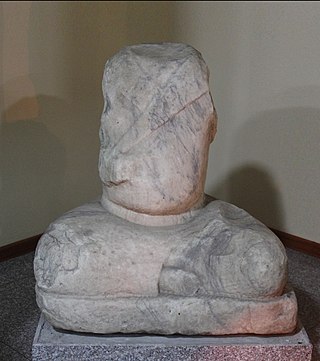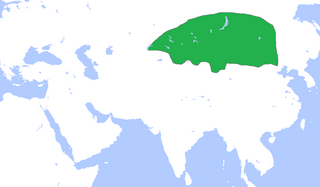Related Research Articles

Bilge Qaghan was the fourth Qaghan of the Second Turkic Khaganate. His accomplishments were described in the Orkhon inscriptions.
Mo-yun Chur (磨延啜) or Eletmish Bilge Qaghan was second qaghan of Uyghur Khaganate. His Tang dynasty invested title was Yingwu Weiyuan Pijia Qaghan or simply Yingwu Qaghan. He was also known as Gelei Qaghan. His official regnal name in Turkic was Tengrida Bolmish Eletmish Bilge Qaghan. He is mostly famous for ordering the erection of the Tariat Inscriptions.
The Uyghur Khaganate was a Turkic empire that existed for about a century between the mid 8th and 9th centuries. It was a tribal confederation under the Orkhon Uyghur (回鶻) nobility, referred to by the Chinese as the Jiu Xing, a calque of the name Toquz Oghuz or Toquz Tughluq.

The Xueyantuo were an ancient Tiele tribe and khaganate in Northeast Asia who were at one point vassals of the Göktürks, later aligning with the Tang dynasty against the Eastern Göktürks.

The Second Turkic Khaganate was a khaganate in Central and Eastern Asia founded by Ashina clan of the Göktürks that lasted between 682–744. It was preceded by the Eastern Turkic Khaganate (552–630) and the early Tang dynasty period (630–682). The Second Khaganate was centered on Ötüken in the upper reaches of the Orkhon River. It was succeeded by its subject Toquz Oghuz confederation, which became the Uyghur Khaganate.
Kutlug I Bilge Boyla Khagan, also known by his throne name Qutlugh Bilge Kül Qaghan, and in Chinese sources the personal name of Yaoluoge Yibiaobi (藥羅葛逸标苾) was the khagan of Uyghur Khaganate, the successor state of the Second Turkic Khaganate, from 744 to 747 AD.

Qocho or Kara-Khoja, also known as Idiqut, was a Uyghur kingdom created in 843, with strong Chinese Buddhist and Tocharian influences. It was founded by refugees fleeing the destruction of the Uyghur Khaganate after being driven out by the Yenisei Kirghiz. They made their winter capital in Qocho and summer capital in Beshbalik. Its population is referred to as the "Xizhou Uyghurs" after the old Tang Chinese name for Gaochang, the "Qocho Uyghurs" after their capital, the "Kucha Uyghurs" after another city they controlled, or the "Arslan ("Lion") Uyghurs" after their king's title.
Kutluk Yabgu Khagan was one of the last yabghus (rulers) of the Second Turkic Khaganate.
Özmiş Khagan - was the last penultimate khagan of the Second Turkic Khaganate (Göktürks).
Qutluğ Säbig Qatun was the khatun (queen) and then hansha of the Second Turkic Khaganate. She served as regent during the minority of Tengri Qaghan in 734-741.

The Karluk Yabghu State was a polity ruled by Karluk tribes.
Alp Bilge Qağan or Eletmiş Qağan was a Basmyl chief who rebelled and brought Second Turkic Khaganate to an end.
Saqal was a Turgesh Qaghan. According to Yuri Zuev, he was a Manichaeist so that his name was possibly derived from Manichean theonym Sakla which means "Creator of the World". Other reconstructions are Saqal and Soq.

Bögü Qaghan or Tengri Qaghan was the third khagan of Uyghurs. He was the younger son of Bayanchur Khagan. His personal name was Yaoluoge Yidijian (藥羅葛移地健) and was titled Ulu Bilge Töles Shad during his father's reign. His subsequent regnal names upon inheriting the throne were Tarkhan Bögü Qaghan, Alp Külüg Bögü Qaghan, and finally Tengrida Qut Bolmish El Tutmish Alp Külüg Bilge Qaghan. He was posthumously renamed as Kün Tengrida Qut Bolmish El Tutmish Alp Külüg Bilge Qaghan by Baoyi Qaghan, stressing his adoption of the Manichean religion. Other titles granted to him were Yingyi Qaghan (英義可汗) - a Tang dynasty invested title and Zahag-i Mani - a Manichaean title.

The Yaglakar clan was the first imperial clan of the Uyghur Khaganate. Descendants of the Yaglakar clan would later establish the Ganzhou Uyghur Kingdom.
Tun Baga Tarkhan or Alp Qutlugh Bilge Qaghan — was the fourth leader of Uyghur Khaganate.
Külüg Bilge Qaghan — 5th leader of Uyghur Khaganate. His Tang invested title was Zhongzhen Qaghan (忠貞可汗). He was born around 772/773.
Qutluq Bilge Qaghan was the sixth khagan of the Uyghur Khaganate and the last one from the Yaglakar clan. His Tang invested title was Fengcheng Qaghan.
Baoyi Qaghan or Alp Bilge Qaghan was the eighth ruler of Uyghurs. His personal name is not known, therefore he is often referred to as his Tang dynasty invested title Baoyi which was invested on 22 June 808.
The - was the second imperial clan of the Uyghur Khaganate.
References
- ↑ Moriyasu, Takao (2015). "New Developments in the History of East Uighur Manichaeism". Open Theology. 1 (1). doi: 10.1515/opth-2015-0016 . ISSN 2300-6579.
- ↑ Invested on 15 June 795
- ↑ New Book of Tang. Vol. 217a.
- ↑ TAŞAĞIL, AHMET (2014-06-26). "Karluklarin Coğrafi Dağilimi Üzerine". Türkiyat Mecmuası. 24 (1): 75. doi:10.18345/tm.09461. ISSN 0085-7432.
- ↑ Mackerras, Colin (1972). The Uighur Empire according to the T'ang Dynastic Histories. A study in Sino-Uighur relations 744-840 (2nd ed.). Canberra: Australian National University Press. ISBN 0708104576. OCLC 624702.
- ↑ Xin, Luo (2013). "Chinese of Karı Çor Tigin Inscription and the Genealogy of Karı Çor Tigin". International Journal of Turkish Literature Culture Education. 2/2 (2): 62–78. doi: 10.7884/teke.187 . ISSN 2147-0146.
- ↑ Ein Manichäisches Buch-Fragment aus Chotscho (in German). 1912. p. 147.
- ↑ Mackerras, Colin. "RELATIONS BETWEEN THE UIGHURS AND TANG CHINA 744–840" (PDF). pp. 93–106.
- ↑ Moriyasu, Takao (2007). Shiruku Rōdo to Tō Teikoku. Tōkyō: Kōdansha. ISBN 9784062807050. OCLC 133116309.
- ↑ "KARABALGASUN ii. The Inscription – Encyclopaedia Iranica". www.iranicaonline.org. Retrieved 2019-10-08.
- ↑ Bosworth, C. E. (2012-04-24). "Rāfiʿ b. al-Layt̲h̲ b. Naṣr b. Sayyār". Encyclopaedia of Islam, Second Edition. doi:10.1163/1573-3912_islam_sim_6184.